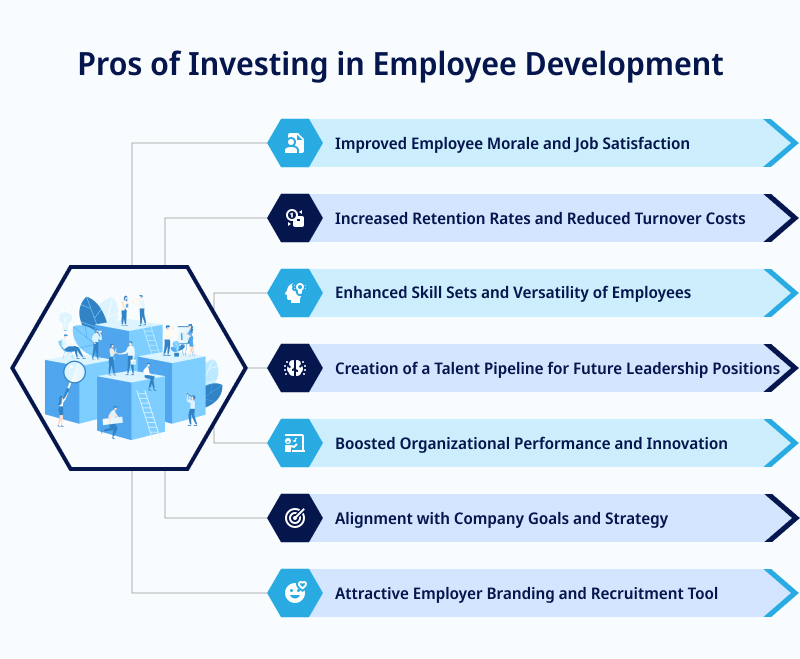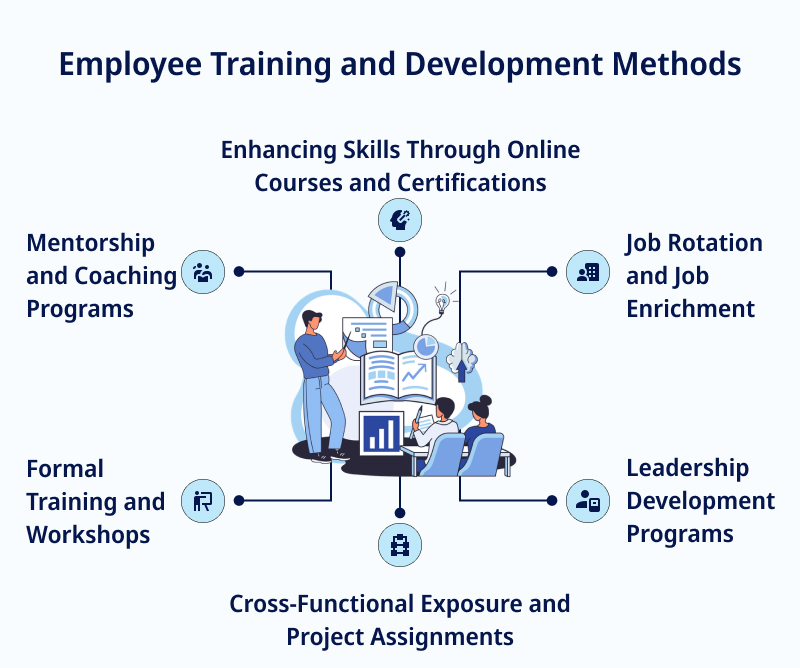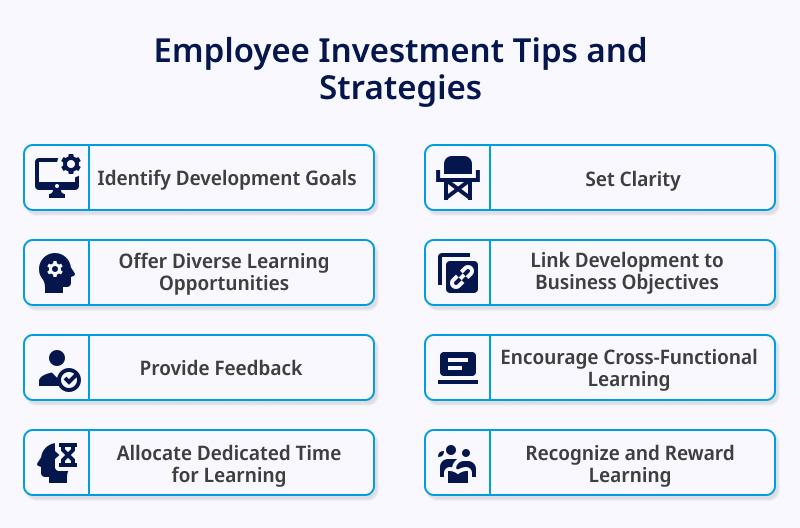In the ever-evolving business landscape, nurturing capable leaders has never been more vital. Yet, organizations often grapple with skill gaps and employee turnover, hindering their potential to thrive.
The solution lies in a strategic approach that transforms employees into empowered leaders ready to tackle the challenges of tomorrow.
Join us as we delve into the imperative of investing in employee development, uncovering the challenges, and presenting proven strategies to shape a leadership-rich future.
Benefits of Employee Development
Employee development is more than just a trendy business term; it’s a potent strategy with several advantages for individual employees and the company. Here are the top benefits of investing in employee development:
Improved Employee Morale and Job Satisfaction
Employees’ job satisfaction and morale greatly rise when they perceive their employer is committed to their professional development. They may feel appreciated, driven, and invested in their work if they acquire new abilities and advance.
Increased Retention Rates and Reduced Turnover Costs
Organisations prioritizing staff development typically report higher employee retention rates and lower turnover costs. Employee retention rates increase when they perceive a clear path for advancement within the organization. This lowers turnover costs related to recruitment, training, and lost productivity.
Enhanced Skill Sets and Versatility of Employees
Employees who participate in ongoing learning acquire information and skills pertinent to their jobs. As a result, they perform better and are more adaptive to shifting work demands and technology improvements.
Creation of a Talent Pipeline for Future Leadership Positions
A pool of qualified people raised through employee development is prepared to take on leadership positions. As a result, fewer outside employees are required, and any organizational growth or change will be handled seamlessly.
Boosted Organizational Performance and Innovation
Well-trained staff members are more effective, productive, and able to make a difference in the company’s success. Their newly acquired talents may also result in original ideas and novel viewpoints that advance the business.
Alignment with Company Goals and Strategy
Employee development can be adapted to conform to the objectives and strategic aims of the firm. By doing this, it is made sure that staff members are prepared to contribute to the organization’s long-term goals.
Attractive Employer Branding and Recruitment Tool
Companies that invest in staff development frequently build a reputation as desirable employers. This may draw top talent looking for chances for personal and professional development.
Types of Employee Development Program
Employee development programs include various activities and tactics to improve workers’ abilities, skills, and knowledge. Let’s examine the different types of employee development initiatives:
Formal Training and Workshops
These organized programs include seminars, workshops, and classroom-style training by internal or external trainers. They cover a range of subjects, including leadership, compliance, technical skills, and communication. Formal training allows workers to meet with subject-matter experts and engage in concentrated learning activities.
Mentorship and Coaching Programs
Mentoring matches staff members with knowledgeable mentors who offer direction, counsel, and career support. Individual sessions are the main emphasis of coaching, which aims to close performance gaps or improve certain abilities. Through frequent encounters, both strategies enable personalized learning and professional development.
Enhancing Skills Through Online Courses and Certifications
Online learning environments allow employees to learn new skills or improve existing ones. Technical skills like programming and soft abilities like time management can be covered in courses. Employees’ competence can be verified by certifications, which can also increase their credibility in the field.
Cross-Functional Exposure and Project Assignments
Employees are exposed to new challenges and abilities when they can work on initiatives outside of their normal responsibilities. This strategy promotes teamwork, broadens the viewpoints of the workforce, and strengthens problem-solving skills. Exposure to multiple functional areas fosters flexibility and adaptability.
Job Rotation and Job Enrichment
Job rotation includes transferring staff members across departments or positions regularly. Job enrichment aims to increase the duties and challenges of an employee’s position. Both approaches offer a variety of experiences while avoiding repetition.
Leadership Development Programs
Programs for leadership development identify high-potential individuals and offer specialized instruction in decision-making, conflict resolution, and strategic thinking. These programs are intended to develop future leaders. Leadership development within the organization ensures a consistent supply of capable leaders.
Tips and Strategies to Invest in Employee Development
Targeted investment in staff development helps a corporation expand and succeed overall while enhancing employees’ individual skills. When investing in employee development, organizations should take into account the following practical tips and strategies:
Identify Development Goals
Conduct regular performance reviews and evaluations to determine an employee’s strengths, shortcomings, and opportunities for progress. This makes adapting development programs to meet personal and organizational objectives easier.
Set Clarity
Work with employees to establish clearly defined, attainable development goals that align with their responsibilities and professional aspirations. Goals that are well-stated increase motivation and give one a sense of purpose.
Offer Diverse Learning Opportunities
Offer a range of learning opportunities, including formal training, workshops, online courses, and mentoring schemes. This allows for various learning styles and guarantees a well-rounded developmental experience.
Link Development to Business Objectives
Align staff development programs with the strategic objectives of the business. This guarantees that learning results contribute to the organization’s success and emphasizes to workers the importance of development.
Provide Feedback
Regularly provide employees with constructive feedback on their development. Employees can trace their development path and make required adjustments with encouragement and assistance.
Encourage Cross-Functional Learning
Encourage cross-functional learning by allowing employees to cooperate with coworkers from various departments or teams. It encourages a comprehensive understanding of the industry and broadens their skill set.
Allocate Dedicated Time for Learning
During working hours, provide designated time for learning and development. This shows the company’s dedication to staff development and guarantees that learning won’t feel like an extra chore.
Recognize and Reward Learning
Recognize and honor staff members engaging in professional development initiatives and exhibiting enhanced abilities. A culture of ongoing learning is strengthened by recognition.
The Bottom Line
Organizations that recognize the invaluable assets of their employees are destined to be a success. It is obvious that fostering a culture of continuous learning and growth results from thriving businesses.
By nurturing employees through tailored training, mentorship, and exposure, businesses forge a path to success that transcends the present and extends into the future. Let’s stand together on this transformative journey, investing in your employees and shaping a brighter future for all.



